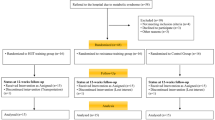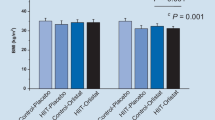Abstract
This study examined the effect of three training intensities on abdominal obesity, insulin resistance, and C-reactive protein (CRP) levels. Forty-three young obese women (age 20–30 years; body mass index 30–40 kg/m2) underwent 12 weeks of walking programs (i.e., 5 days/week). They were randomly assigned to one of four groups: low-intensity training group [G1, 50 % of heart rate reserve (HRR), n = 11], high-intensity training group (G2, 75 % of HRR, n = 10), alternated-intensity training group (G3, 50–75 % of HRR, n = 12), and control group (G0, n = 10). They were tested before (T0) and after (T1) 12 weeks of aerobic training to determine changes in body mass, body mass index (BMI), total fat, waist circumference (WC), leptin, HOMA-IR, glucose and CRP. Body mass, BMI, total fat, and WC were significantly lower at T1 than T0 (p < 0.001) in all training groups. However, the decrease was higher in G2 than G1 and G3. Leptin levels decreased significantly in G1, G2, and G3 (p < 0.05). Only G1 showed significant decreases in CRP levels (p < 0.05). Insulin, HOMA-IR, and glucose levels decreased in the three training groups with higher decrease in G1. The low-intensity training is more effective than the high-intensity training or alternated-intensity training for improving insulin sensitivity and reducing subclinical inflammation.
Similar content being viewed by others
References
Mezghanni N, Chaabouni K, Chtourou H, Masmoudi L, Chamari K, Lassoued AB, Mnif M, Jamoussi K, Mejdoub H (2012) Effect of exercise training intensity on body composition, lipid profile, and insulin resistance in young obese women. Afr J Microbiol Res 6:2481–2488
Yudkin JS, Stehouwer CD, Emeis JJ, Coppack SW (1999) C-reactive protein in healthy subjects: associations with obesity, insulin resistance, and endothelial dysfunction: a potential role for cytokines originating from adipose tissue? Arterioscler Thromb Vasc Biol 19:972–978
Moran Un, Steffen LM, Jacobs DR Jr, Steinberger J, Pankow JS, Hong CP, Tracy RP, Sinaiko AR (2005) Relation de la protéine C-réactive à la résistance à l’insuline et cardio-vasculaires facteurs de risque dans les jeunes. Diabetes Care 28:1763–1768
Ridker PM, Furing JE, Cook NR, Rifai N (2003) C-reactive protein, the metabolic syndrome, and risk of incident cardiovascular events. Circulation 107:391–397
Ruan H, Hacohen N, Golub TR, Van Parijs L, Lodish HF (2002) Tumor necrosis factor–alpha suppresses adipocyte-specific genes and activates expression of preadipocyte genes in 3T3-L1 adipocytes: nuclear factor–kappaB activation by TNF-alpha is obligatory. Diabetes 51:1319–1336
Ridker PM, Buring JE, Shih J, Matias M, Hennekens CH (1998) Prospective study of C-reactive protein and the riskof future cardiovascular events among apparently healthy women. Circulation 98:731–733
Tai ES, Lau TN, Ho SC, Fok AC, Tan CE (2000) Body fat distribution and cardiovascular risk in normal weight women. Associations with insulin resistance, lipids and plasma leptin. Int J Obes Relat Metab Disord 24:751–757
Shamsuzzaman AS, Winnicki M, Wolk R, Svatikova A, Phillips BG, Davison DE, Berger PB, Somers VK (2004) Independent association between plasma leptin and C-reactive protein in healthy humans. Circulation 109:2181–2185
Singh P, Hoffmann M, Wolk R, Shamsuzzaman AS, Somers VK (2007) Leptin induces C-reactive protein expression in vascular endothelial cells. Arterioscler Thromb Vasc Biol 27:302–307
Lemieux I, Poirier P, Bergeron J, Alméras N, Lamarche B, Cantin B, Dagenais GR, Després JP (2007) Hypertriglyceridemic waist: a useful screening phenotype in preventive cardiology? Can J Cardiol 23:23–31
Nguyen-Duy TB, Nichaman MZ, Church TS, Blair SN, Ross R (2003) Visceral fat and liver fat are independent predictors of metabolic risk factors in men. Am J Physiol Endocrinol Metab 284:1065–1071
Nicklas BJ, Wang X, You T, Lyles MF, Demons J, Easter L, Berry MJ, Lenchik L, Carr JJ (2009) Effect of exercise intensity on abdominal fat loss during calorie restriction in overweight and obese postmenopausal women: a randomized, controlled trial. Am J Clin Nutr 89:1043–1052
Chtourou H, Aloui A, Hammouda O, Chaouachi A, Chamari K, Souissi N (2013) The effect of time-of-day and judo match on short-term maximal performances judokas. Biol Rhythm Res 44:797–806
Hammouda O, Chahed H, Chtourou H, Ferchichi S, Miled A, Souissi N (2012) Morning-to-evening difference of biomarkers of muscle injury and antioxidant status in young trained soccer players. Biol Rhythm Res 43:431–438
Hammouda O, Chtourou H, Chaouachi A, Chahed H, Bellimem H, Chamari K, Souissi N (2013) Time-of-day effects on biochemical responses to soccer-specific endurance in elite Tunisian football players. J Sports Sci 31:963–971
HajSalem M, Chtourou H, Aloui A, Hammouda O, Souissi N (2013) Effects of partial sleep-deprivation at the end of the night on anaerobic performances in Judokas. Biol Rhythm Res 44:815–821
Abedelmalek S, Chtourou H, Aloui A, Aouichaoui C, Souissi N, Tabka Z (2012) Effect of time of day and partial sleep deprivation on plasma concentrations of IL-6 during a short-term maximal performance. Eur J Appl Physiol 113:241–248
Abedelmalek S, Souissi N, Chtourou H, Denguezli M, Aouichaoui C, Ajina M, Aloui A, Dogui M, Haddouk S, Tabka Z (2013) Effects of partial sleep deprivation on proinflammatory cytokines, growth hormone, and steroid hormone concentrations during repeated brief sprint interval exercise. Chronobiol Int 30:502–509
Karvonen MJ, Kentala E, Mustala O (1957) The effects of training on heart rate; a longitudinal study. Ann Med Exp Biol Fenn 35:307–315
Aloui A, Chaouachi A, Chtourou H, Wong DP, Haddad M, Chamari K, Souissi N (2012) Effects of ramadan on the diurnal variations of repeated sprints performances. Int J Sports Physiol Perform 8:254–262
Hammouda O, Chtourou H, Chahed H, Ferchichi S, Kallel C, Miled A, Chamari K, Souissi N (2011) Diurnal variations of plasma homocysteine, total antioxidant status, and biological markers of muscle injury during repeated sprint: effect on performance and muscle fatigue—a pilot study. Chronobiol Int 28:958–967
Hammouda O, Chtourou H, Chaouachi A, Chahed H, Zarrouk N, Miled A, Chamari K, Souissi N (2013) Biochemical responses to level-1 yo–yo intermittent recovery test in young Tunisian football players. Asian J Sport Med 4:23–28
Hammouda O, Chtourou H, Chaouachi A, Chahed H, Ferchichi S, Kallel C, Chamari K, Souissi N (2012) Effect of short-term maximal exercise on biochemical markers of muscle damage, total antioxidant status, and homocysteine levels in football players. Asian J Sport Med 3:239–246
Hammouda O, Chtourou H, Chahed H, Ferchichi S, Chaouachi A, Kallel C, Miled A, Chamari K, Souissi N (2012) High intensity exercise affects diurnal variation of some biological markers in trained subjects. Int J Sports Med 33:886–891
Friedewald WT, Levy RI, Fredrickson DS (1972) Estimation of the concentration of low-density lipoprotein cholesterol in plasma, without use of the preparative ultracentrifuge. Clin Chem 18:499–502
Wallace TM, Levy JC, Matthews DR (2004) Use and abuse of HOMA modeling. Diabetes Care 27:1487–1495
Shephard RJ (2002) Cytokine responses to physical activity, with particular reference to IL-6: sources, actions, and clinical implications. Crit Rev Immunol 22:165–182
McLaughlin T, Abbasi F, Lamendola C, Liang L, Reaven G, Schaaf P, Reaven P (2002) Differentiation between obesity and insulin resistance in the association with C-reactive protein. Circulation 106:2908–2912
Febbraio MA, Pedersen BK (2002) Muscle-derived interleukin-6: mechanisms for activation and possible biological roles. FASEB 16:1335–1347
Nakanishi S, Yamane K, Kamei N, Okubo M, Kohno N (2003) Elevated C-reactive protein is a risk factor for the development of type 2 diabetes in Japanese Americans. Diabetes Care 26:2754–2757
Nassisa GP, Papantakoua K, Skenderia K, Triandafillopouloud M, Kavourasa SA, Yannakouliaa M, Chrousosc GP, Sidossis LS (2005) Aerobic exercise training improves insulin sensitivity without changes in body weight, body fat, adiponectin, and inflammatory markers in overweight and obese girls. Metab Clin Exp 54:1472–1479
Bruce CR, Hawley JA (2004) Improvements in insulin resistance with aerobic exercise training: a lipocentric approach. Med Sci Sports Exerc 36:1196–1201
Luzi L, Cavadini V, Bognetti E, Alberti G, Battezzati A, Piceni Sereni L, Chiumello G (2004) Insulin sensitivity of protein and glucose metabolism in overweight female adolescents with type 1 diabetes mellitus: positive modulation by physical exercise. Sport Sci Health 1:41–46
Alireza S, Arshin AS, Elahe TG, Rozita F, Marziyeh S (2013) Aerobic or resistance training improves anthropometric and metabolic parameters in overweight/obese women without any significant alteration in plasma vaspin levels. Sport Sci Health 9:121–126
He J, Goodpaster BH, Kelley DE (2004) Effects of weight loss and physical activity on muscle lipid content and droplet size. Obes Res 12:76–79
Montez JM, Saukas A, Asilmaz E, Fayzikhodjaeva G, Fantuzzi G, Friedman JM (2005) Acute leptin deficiency, leptin resistance, and the physiologic response to leptin withdrawal. Proc Natl Acad Sci 102:2537–2542
Senn JJ, Klover PJ, Nowak IA, Zimmers TA, Koniaris LG, Furlanetto RW, Mooney RA (2003) Suppressor of cytokine signaling-3 (SOCS-3), a potential mediator of interleukin-6-dependent insulin resistance in hepatocytes. J Biol Chem 278:13740–13746
Fernandez-Real JM, Ricart W (2003) Insulin resistance and chronic cardiovascular inflammatory syndrome. Endocr Rev 24:278–301
Bouassida A, Chamari K, Zaouali M, Feki Y, Zbidi A, Tabka Z (2010) Review on leptin and adiponectin responses and adaptations to acute and chronic exercise. Br J Sports Med 44:620–630
Langenberg C, Bergstrom J, Scheidt-Nave C, Pfeilschifter J, Barrett-Connor E (2006) Cardiovascular death and the metabolic syndrome: role of adiposity-signaling hormones and inflammatorymarkers. Diabetes Care 29:1363–1369
Seufert J, Kieffer TJ, Leech CA, Holz GG, Moritz W, Ricordi C, Habener JF (1999) Leptin suppression of insulin secretion and gene expression in human pancreatic islets: implications for the development of adipogenic diabetes mellitus. J Clin Endocrinol Metab 84:670–676
Thong FS, Hudson R, Ross R, Janssen I, Graham TE (2000) Plasma leptin in moderately obese men: independent effects of weight loss and aerobic exercise. Am J Physiol Endocrinol Metab 279:307–313
De Luis DA, Aller R, Izaola O, Gonzalez Sagrado M, Conde R, Perez Castrillon JL (2008) Effects of lifestyle modification on adipocytokine levels in obese patients. Eur Rev Med Pharmacol Sci 12:33–39
Hickey MS, Houmard JA, Considine RV, Tyndall GL, Midgette JB, Gavigan KE, Weidner ML, McCammon MR, Israel RG, Caro JF (1997) Gender-dependent effects of exercise training on serum leptin levels in humans. Am J Physiol 272:562–566
Hukshorn CJ, Lindeman JH, Toet KH, Saris WH, Eilers PH, Westerterp-Plantenga MS, Kooistra T (2004) Leptin and the Proinflammatory State Associated with Human Obesity. J Clin Endocrinol Metab 89:1773–1778
Koutkia P, Canavan B, Johnson ML, DePaoli A, Grinspoon S (2003) Characterization of leptin pulse dynamics and relationship to fat mass, growth hormone, cortisol, and insulin. Am J Physiol Endocrinol Metab 285:372–379
Gomez-merio D, Chennaoui M, Guezennec CY (2004) Leptine et exercice physique. Sci Sport 19:8–18
Acknowledgments
The authors wish to express their sincere gratitude to all participants for their cooperation. This study was financially supported by the Ministry of Higher Education and Scientific Research, Tunisia.
Conflict of interest
The authors declare that they have no conflict of interest.
Ethical standard
All institutional and national guidelines for care and use of laboratory were followed. All procedures followed were in accordance with the ethical standards of the responsible committee on human experimentation (institutional and national) and with the Helsinki Declaration of 1975, as revised in 2000 (5). Informed consent was obtained from all patients for being included in the study.
Author information
Authors and Affiliations
Corresponding author
Rights and permissions
About this article
Cite this article
Mezghanni, N., Mnif, M., Chtourou, H. et al. Effect of aerobic training on insulin resistance and C-reactive protein (CRP) levels and subcutaneous abdominal in obese women. Sport Sci Health 10, 111–118 (2014). https://doi.org/10.1007/s11332-014-0181-1
Received:
Accepted:
Published:
Issue Date:
DOI: https://doi.org/10.1007/s11332-014-0181-1




